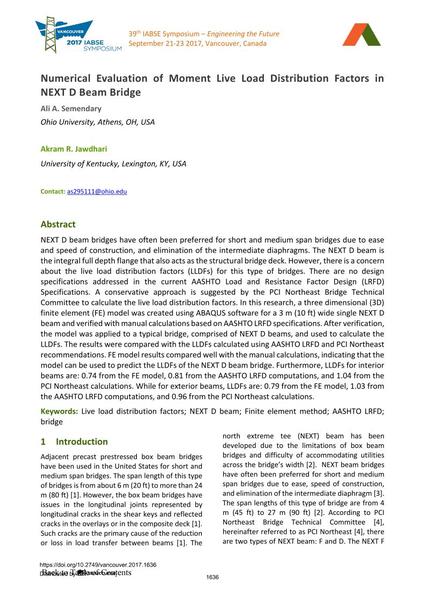Numerical Evaluation of Moment Live Load Distribution Factors in NEXT D Beam Bridge

|
|
|||||||||||
Bibliographic Details
| Author(s): |
Ali A. Semendary
(Ohio University, Athens, OH, USA)
Akram R. Jawdhari (University of Kentucky, Lexington, KY, USA) |
||||
|---|---|---|---|---|---|
| Medium: | conference paper | ||||
| Language(s): | English | ||||
| Conference: | IABSE Symposium: Engineering the Future, Vancouver, Canada, 21-23 September 2017 | ||||
| Published in: | IABSE Symposium Vancouver 2017 | ||||
|
|||||
| Page(s): | 1636-1643 | ||||
| Total no. of pages: | 8 | ||||
| Year: | 2017 | ||||
| DOI: | 10.2749/vancouver.2017.1636 | ||||
| Abstract: |
NEXT D beam bridges have often been preferred for short and medium span bridges due to ease and speed of construction, and elimination of the intermediate diaphragms. The NEXT D beam is the integral full depth flange that also acts as the structural bridge deck. However, there is a concern about the live load distribution factors (LLDFs) for this type of bridges. There are no design specifications addressed in the current AASHTO Load and Resistance Factor Design (LRFD) Specifications. A conservative approach is suggested by the PCI Northeast Bridge Technical Committee to calculate the live load distribution factors. In this research, a three dimensional (3D) finite element (FE) model was created using ABAQUS software for a 3 m (10 ft) wide single NEXT D beam and verified with manual calculations based on AASHTO LRFD specifications. After verification, the model was applied to a typical bridge, comprised of NEXT D beams, and used to calculate the LLDFs. The results were compared with the LLDFs calculated using AASHTO LRFD and PCI Northeast recommendations. FE model results compared well with the manual calculations, indicating that the model can be used to predict the LLDFs of the NEXT D beam bridge. Furthermore, LLDFs for interior beams are: 0.74 from the FE model, 0.81 from the AASHTO LRFD computations, and 1.04 from the PCI Northeast calculations. While for exterior beams, LLDFs are: 0.79 from the FE model, 1.03 from the AASHTO LRFD computations, and 0.96 from the PCI Northeast calculations. |
||||
| Keywords: |
bridge finite element method (FEM) AASHTO LRFD live load distribution factors NEXT D beam
|
||||
